Polytechnic of Bari (Italy)
Architectural Photogrammetry Laboratory
Photogrammetric restitution

The restitution phase concerns the use of the information contained in the survey.
Up to the arrival of digital photography, photogrammetric restitution was defined as the orthogonal projection of what appears in the pair of frames, obtained by means of optical-mechanical equipment, called photogrammetric restitutors. Thanks to these devices, the operator can move on the optical-three-dimensional model (which he observes with stereoscopic vision) a mobile brand, whose displacements in the xyz directions can be registered in order to obtain the representation in the xy (plan) or xz planes ( prospectus).
With the advent of digital photography and the possibility of recording the spatial coordinates of the mobile brand, it was possible to use them not only for the representation in orthogonal projection, also for modeling and, thanks to the reverse photogrammetry, make changes on the pair of frames, in order to represent the restoration project with stereometric images. Furthermore, the use of digital documentation allows the dissemination, via the network, of all restitution works relating to the same survey and, therefore, their possible correction and / or integration.
Let's consider the Matrix church of Cisternino (BR).
Avoiding dwelling on the techniques with which the metric information was acquired, we focus our attention on the return phase. We have already said about this relief, now let's see how best to use graphic representations.
As regards the two-dimensional representation, it is necessary to immediately warn against the danger that is encountered with the numerical representation. The possibility, offered by CAD programs, of being able to enlarge or reduce the drawings, has even led to the creation of large-scale urban plans, in which it is possible to see the plans of the buildings. In essence, there is the risk of forgetting a basic principle of drawing: for each scale of representation there is a language and a very precise symbolism.
 Here we immediately exclude any two-dimensional representation and note that the stereometric model is obtained with two perspective views, taken according to the normal case. With these premises, let's focus on the presentation of the survey.
Here we immediately exclude any two-dimensional representation and note that the stereometric model is obtained with two perspective views, taken according to the normal case. With these premises, let's focus on the presentation of the survey.
We will almost certainly exclude the axonometric view and always opt for the perspective one. At this point it remains to choose a perspective view from below, one of the roof, a horizontal section of the bodies annexed to the church, possibly from several points of view, and a horizontal section of the whole complex, always in perspective. The same applies to vertical sections.
If we move inside, things get slightly complicated. We could use a 360 ° shot or take a general view on which information can also be reported in a color of your choice.
This type of representation, albeit fascinating, leads us to a crossroads: to push the same graphic representation more and more into details or to use it as a scheme of the monument destined to recall photographic images, perhaps stereometric. The first solution appears, at first glance, interesting, considering that the modeling program operates on a 1: 1 scale, but we would always be in the presence of a subjective representation. The second way, on the other hand, makes it possible to make the relief thematic and to comfort it with photographic references, such as the image of a capital, a detail of an environment, a vault or the dome. These photographic shots can be repeated after some time and dated, but we can even make the click, on an area of the graphic relief, recall the image of a webCam placed in the corresponding area of the monument.